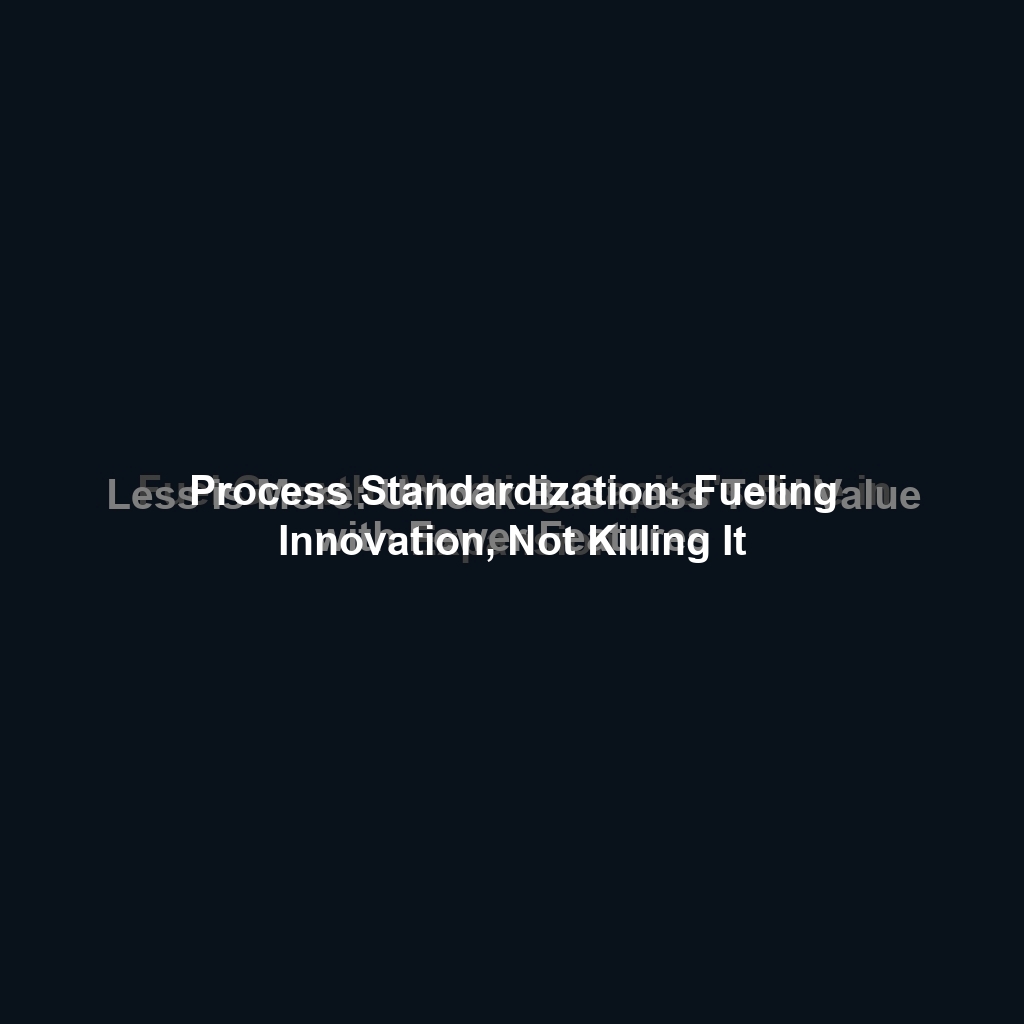Scaling a business is a thrilling, albeit challenging, journey. As organizations grow, the need for standardized processes becomes increasingly apparent. Without them, chaos reigns, efficiency plummets, and quality suffers. However, a rigid, process-heavy environment can stifle innovation, hindering the very agility that fueled early success. The key lies in finding the sweet spot: standardizing strategically while preserving the freedom to experiment and adapt.
The Standardization Paradox: Structure vs. Flexibility
The pressure to standardize often comes from very real pain points. Think about a startup where marketing, sales, and customer support were initially handled by a handful of individuals. As the customer base expands, relying on ad-hoc communication and undocumented procedures quickly becomes unsustainable. Missed leads, inconsistent messaging, and frustrated customers become the norm. Standardizing these processes seems like the obvious solution, and in many ways, it is. However, standardization taken too far can create bureaucracy, slow down decision-making, and discourage employees from thinking outside the box.
This is the standardization paradox: the very structure that’s meant to improve efficiency can inadvertently kill the innovative spirit that drives growth. We’ll explore how to navigate this paradox and create a system that fosters both efficiency and agility.
Real-World Scenario: The SaaS Startup’s Dilemma
I worked with a SaaS startup that experienced rapid growth in its first year. Their initial success was largely attributed to their ability to quickly adapt to customer feedback and release new features at an impressive pace. However, as their customer base grew, their development process became increasingly chaotic. Bugs were slipping through the cracks, deployment cycles were unpredictable, and the development team was constantly firefighting. They needed to standardize their development process, but they were afraid of losing their agility.
Their challenge exemplifies the paradox perfectly.
Identifying Core Processes for Standardization
Not all processes are created equal. Some are critical for maintaining quality, compliance, and consistency, while others are more conducive to experimentation and innovation. The first step is to identify the core processes that would benefit most from standardization. These are typically processes that:
- Are repeated frequently.
- Involve multiple people or departments.
- Have a direct impact on customer satisfaction.
- Are subject to regulatory requirements.
- Present a high risk of errors or inconsistencies.
Conversely, processes that are highly creative, experimental, or subject to frequent change should generally be left more flexible. These are often areas where innovation thrives, and imposing rigid structures can be counterproductive.
A Framework for Process Prioritization
Use the following framework to prioritize processes for standardization:
- Identify all key processes: List every major activity within your organization, from onboarding new employees to processing customer orders.
- Assess the impact of standardization: For each process, consider the potential benefits of standardization in terms of efficiency, quality, compliance, and customer satisfaction.
- Evaluate the impact on innovation: Assess the potential negative impact of standardization on creativity, experimentation, and agility.
- Prioritize based on risk/reward: Focus on standardizing processes that offer the highest potential benefits with the lowest risk to innovation.
Key Insight: Standardize processes that provide the biggest “bang for your buck” in terms of efficiency and compliance while preserving flexibility in areas vital for competitive differentiation.
Techniques for Preserving Flexibility While Standardizing
Standardization doesn’t have to mean rigidity. Several techniques can help you create structured processes that still allow for flexibility and innovation:
1. Define Clear Boundaries, Not Rigid Steps
Instead of prescribing every single step in a process, focus on defining clear boundaries and guidelines. This provides a framework for consistency while allowing employees to use their judgment and creativity within those boundaries.
Example: Instead of dictating the exact wording of a sales email, provide a template with key talking points and a clear call to action. Allow sales reps to personalize the message and adapt it to the specific needs of each prospect.
2. Embrace Modularity and Optionality
Design processes as a series of modular components that can be combined and configured in different ways. This allows for customization and flexibility without sacrificing overall structure.
Example: A customer support process could consist of modules for issue triage, troubleshooting, escalation, and resolution. Depending on the nature of the issue, the support agent can choose the appropriate modules and follow the relevant steps.
3. Foster a Culture of Experimentation and Feedback
Encourage employees to experiment with new approaches and provide feedback on existing processes. This creates a culture of continuous improvement and ensures that processes remain relevant and effective.
Example: Implement a “process improvement suggestion box” where employees can submit ideas for streamlining or improving existing processes. Regularly review these suggestions and implement the most promising ones.
4. Leverage Technology for Automation and Customization
Use technology to automate repetitive tasks and provide customizable options. This frees up employees to focus on more complex and creative work while ensuring consistency and efficiency.
Example: Implement a CRM system that automatically tracks customer interactions and provides sales reps with personalized recommendations based on past behavior.
5. Regularly Review and Update Processes
Processes should not be set in stone. Regularly review and update them to reflect changing business needs and customer expectations. This ensures that processes remain relevant and effective over time.
Example: Conduct a quarterly review of all key processes and identify areas for improvement based on performance data and employee feedback.
Documenting Processes Effectively: Templates and Frameworks
Effective process documentation is crucial for ensuring that everyone understands and follows standardized procedures. However, documentation should be clear, concise, and easy to update. Here are some templates and frameworks that can help:
1. Flowcharts
Flowcharts are a visual way to represent a process, showing the sequence of steps and decision points. They are particularly useful for complex processes with multiple branches.
Example: A flowchart for the customer onboarding process could show the steps involved in setting up a new account, providing training, and offering ongoing support.
2. Standard Operating Procedures (SOPs)
SOPs provide detailed, step-by-step instructions for performing a specific task. They are essential for ensuring consistency and compliance.
Template:
**SOP Title:** [Process Name]
**Purpose:** [Briefly describe the purpose of the process]
**Scope:** [Define the scope of the process, i.e., who is responsible and what it applies to]
**Procedure:**
1. **Step 1:** [Describe the first step in detail]
* [Any specific instructions or guidelines]
2. **Step 2:** [Describe the second step in detail]
* [Any specific instructions or guidelines]
3. **Step 3:** [And so on...]
**Related Documents:** [List any related documents or resources]
**Revision History:** [Track changes to the SOP]
3. Checklists
Checklists provide a simple way to ensure that all necessary steps are completed in a specific order. They are particularly useful for tasks that involve multiple steps or require attention to detail.
Example: A checklist for launching a new marketing campaign could include items such as: “Define target audience,” “Create marketing materials,” “Set up tracking,” and “Monitor results.”
4. RACI Matrix
A RACI matrix defines the roles and responsibilities for each step in a process. It clarifies who is Responsible, Accountable, Consulted, and Informed.
Example:
| Process Step | Responsible | Accountable | Consulted | Informed |
|---|---|---|---|---|
| Create Sales Proposal | Sales Rep | Sales Manager | Marketing Team | Project Manager |
| Review Sales Proposal | Sales Manager | Sales Director | Sales Rep | Project Manager |
Key Insight: Document your processes in a way that is easy to understand and update. Visual aids like flowcharts and checklists can be particularly helpful.
Balancing Standardization and Innovation: A Cultural Shift
Ultimately, balancing standardization and innovation requires a cultural shift within the organization. This means fostering a culture that values both efficiency and creativity, and that empowers employees to take ownership of processes and suggest improvements.
1. Empower Employees to Own Processes
Involve employees in the process of designing and implementing standardized procedures. This gives them a sense of ownership and makes them more likely to follow the procedures correctly. Encourage them to identify areas for improvement and to suggest ways to streamline or optimize the processes.
Example: When standardizing the customer onboarding process, involve customer support representatives, sales reps, and account managers in the design process. This ensures that the process meets the needs of all stakeholders and that everyone is on board with the new procedures.
2. Create Dedicated Time for Innovation
Dedicate specific time and resources for employees to experiment with new ideas and develop innovative solutions. This could involve setting aside a certain percentage of work time for “innovation projects” or creating a dedicated innovation lab.
Example: Google’s famous “20% time” policy allows employees to spend 20% of their work time on projects of their own choosing. This has led to the development of many successful Google products, including Gmail and AdSense. While 20% may not be feasible for all organizations, dedicating even a small amount of time to innovation can yield significant results.
3. Celebrate Both Efficiency and Innovation
Recognize and reward employees who contribute to both efficiency and innovation. This reinforces the message that both are valued by the organization.
Example: Create an “Employee of the Month” award that recognizes employees who have made significant contributions to either efficiency or innovation. Publicly acknowledge their achievements and reward them with bonuses or other incentives.
4. Lead by Example
Leaders must demonstrate a commitment to both standardization and innovation. This means following standardized procedures themselves and encouraging their teams to do the same. It also means being open to new ideas and supporting employees who are willing to take risks and experiment.
Personal Anecdote: The Agile Marketing Transformation
In my experience, one of the most effective ways to balance standardization and innovation is to adopt an agile mindset. I once led a marketing transformation at a large financial services company that was struggling to keep up with the rapid pace of change in the digital landscape. Their marketing processes were highly bureaucratic and inflexible, making it difficult to respond quickly to new opportunities. By implementing agile marketing principles, we were able to create a more streamlined and adaptive marketing organization. We standardized key processes such as campaign planning and execution, but we also empowered teams to experiment with new channels and tactics. This allowed us to improve efficiency and consistency while also fostering a culture of innovation. The results were dramatic: we saw a significant increase in marketing ROI and a noticeable improvement in employee morale.
Avoiding Common Pitfalls
Even with the best intentions, it’s easy to fall into common traps when standardizing processes. Being aware of these pitfalls can help you avoid them:
- Over-Standardization: Standardizing too many processes or making them too rigid can stifle innovation and create bureaucracy.
- Ignoring Employee Feedback: Failing to involve employees in the process of designing and implementing standardized procedures can lead to resistance and lower adoption rates.
- Neglecting Process Maintenance: Processes that are not regularly reviewed and updated can become outdated and ineffective.
- Lack of Communication: Failing to communicate the reasons for standardization and the benefits it will provide can lead to confusion and resistance.
- Focusing on Activity, Not Outcomes: Standardizing activities without measuring their impact on desired outcomes can lead to wasted effort and a false sense of progress.
Conclusion: A Continuous Journey
Standardizing processes without stifling innovation is not a one-time project, but a continuous journey. It requires a commitment to both efficiency and creativity, and a willingness to adapt and evolve over time. By following the techniques and frameworks outlined in this article, you can create a system that fosters both structure and flexibility, enabling your organization to scale effectively while maintaining its competitive edge.
Remember, the goal is not to eliminate all variation, but to manage it strategically. By standardizing the right processes, empowering employees, and fostering a culture of experimentation, you can create an organization that is both efficient and innovative.
If you’re grappling with scaling your business while maintaining agility, reaching out for expert guidance can provide tailored solutions. Let’s connect to explore how we can help you strike the perfect balance.
References:
This article was optimized and published by Content Hurricane.


